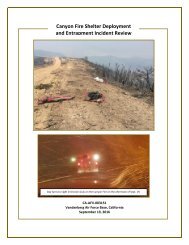Final Report to the Joint Fire Science Program
13-1-04-45_final_report
13-1-04-45_final_report
You also want an ePaper? Increase the reach of your titles
YUMPU automatically turns print PDFs into web optimized ePapers that Google loves.
Coop & Magee P-J Fuel Treatment Effects 12/31/2016<br />
stands, fur<strong>the</strong>r precaution is warranted on <strong>the</strong> part of managers in prescribing treatments,<br />
particularly in relatively pristine areas lacking <strong>the</strong>se species. Best management practices <strong>to</strong><br />
prevent introduction, including washing machinery <strong>to</strong> remove seeds prior <strong>to</strong> site entry, will<br />
continue <strong>to</strong> be valuable, but post-treatment control measures might also be considered. The<br />
second explanation suggests increased caution is needed in areas already containing a rich nonnative<br />
species pool, where treatments may trigger population expansions. Preventing<br />
introduction by cleaning machinery may not be useful if seed sources on site are subsequently<br />
dispersed throughout treatments units. Here, managers might consider proactive, pre-treatment<br />
weed control measures. O<strong>the</strong>r authors have recommended seeding treatments with native species<br />
(Redmond et al., 2014; Young et al., 2013). Increased competition with natives, particularly at<br />
early stages of invasion, may be helpful, but <strong>the</strong> potential for contaminated seed mixes also poses<br />
risks. In addition <strong>to</strong> pre- and post-treatment weed control measures, piles of mastication debris<br />
could be redistributed across treatment units <strong>to</strong> reduce bare soil cover and eliminate<br />
microenvironments conducive <strong>to</strong> cheatgrass colonization adjacent <strong>to</strong> mulch piles.<br />
Retain More Trees<br />
Modeled fire behavior suggests that under most conditions, treatments will be highly effective at<br />
reducing active crown fire risk, but also that treatments generally removed more trees than<br />
necessary <strong>to</strong> mitigate this risk. Under moderate burning conditions (80 th percentile), model<br />
outputs suggest that most untreated stands could not support active crown fire. Even under<br />
extreme burning conditions (97 th percentile), stands with canopy cover at 15% did not support<br />
active crown fire. In contrast, treatments averaged only 6% canopy cover. While <strong>the</strong>se model<br />
outputs should be viewed as hypo<strong>the</strong>ses that require fur<strong>the</strong>r empirical testing, <strong>the</strong>y suggest that<br />
managers may be able <strong>to</strong> acceptably reduce fire hazard in most settings with less aggressive<br />
treatments. Retention of more trees within treatments will benefit P-J obligate birds and may also<br />
result in less expansion by non-native plant species. We also encourage managers <strong>to</strong> experiment<br />
with different treatment configurations that retain larger islands of intact habitat, ra<strong>the</strong>r than<br />
uniformly spaced but highly artificial P-J “savannas”.<br />
Follow-up Measures <strong>to</strong> Increase <strong>Fire</strong> Resistance<br />
Decreased canopy fuels and increased herbaceous surface fuels including exotic annuals are<br />
expected <strong>to</strong> alter potential fire behavior via reduced active crown fire probability, but also<br />
increased surface fire intensity, flame length, and rate of spread. <strong>Fire</strong> behavior models indicated<br />
that most residual trees were still highly susceptible <strong>to</strong> passive crown fire (<strong>to</strong>rching), particularly<br />
in grassy and masticated sites with high surface fuel loads. Models including simulated treatment<br />
modifications suggest that this remaining crown fire risk could mostly be eliminated via followup<br />
surface fuel reductions (e.g., Rx fire) and/or crown base height increases (e.g., pruning). As<br />
such, we propose that managers consider additional post-treatment fuels interventions <strong>to</strong> increase<br />
<strong>the</strong> landscape-scale fire resistance, which is anticipated <strong>to</strong> yield both social and ecological<br />
benefit. Reductions of woody surface fuels might be achieved through post-treatment, prescribed<br />
burning, though this may promote additional expansion by non-native species, and additional<br />
moni<strong>to</strong>ring and research are needed. We also recommend managers experiment with follow-up<br />
pruning of low tree branches <strong>to</strong> increase crown base height and fire-resistance of residual trees,<br />
12




